Abstract
BACKGROUND--Several studies have shown that both objective and subjective measurements are related to exercise capacity in patients with chronic obstructive pulmonary disease (COPD). In this study the relative contribution of lung function, maximal inspiratory pressure, dyspnoea, and quality of life to the performance in a walking distance test and a bicycle ergometer test was investigated. METHODS--Static lung volumes, forced expiratory volume in one second (FEV1), inspiratory slow vital capacity (IVC), transfer factor for carbon monoxide (TLCO) divided by the alveolar volume (TLCO/VA), static compliance (Cst), and maximal inspiratory peak pressure (PImaxPOES) were measured in 40 patients with COPD with severe airways obstruction (mean FEV1 44% predicted, mean FEV1/IVC 37% predicted). Quality of life was assessed by the Chronic Respiratory Questionnaire (CRQ) and dyspnoea by the Borg category scale. Exercise capacity was measured by both a six minute walking distance (test) and a maximal work load of the bicycle ergometer test (Wmax). RESULTS--Spirometric values and maximal inspiratory pressure were modestly correlated with both the six minute walking test and Wmax, r values ranging from 0.50 to 0.58. The TLCO was strongly correlated with the six minute walking test (r = 0.62) and with Wmax (r = 0.78). Quality of life showed no correlation with exercise capacity, while there was a correlation between dyspnoea and the six minute walking test (r = -0.41). Backward linear regression analysis selected TLCO and PImaxPOES as the most significant determinants for exercise performance. They explained 54% and 69% of the variance in the six minute walking test and Wmax, respectively. CONCLUSIONS--The results show that exercise capacity in patients with COPD with severe airways obstruction is more strongly related to inspiratory muscle strength and lung function than to dyspnoea and quality of life. The significant correlation between dyspnoea and the six minute walking test suggests that subjective variables are more strongly related to walking tests than to bicycle ergometer tests.
Full text
PDF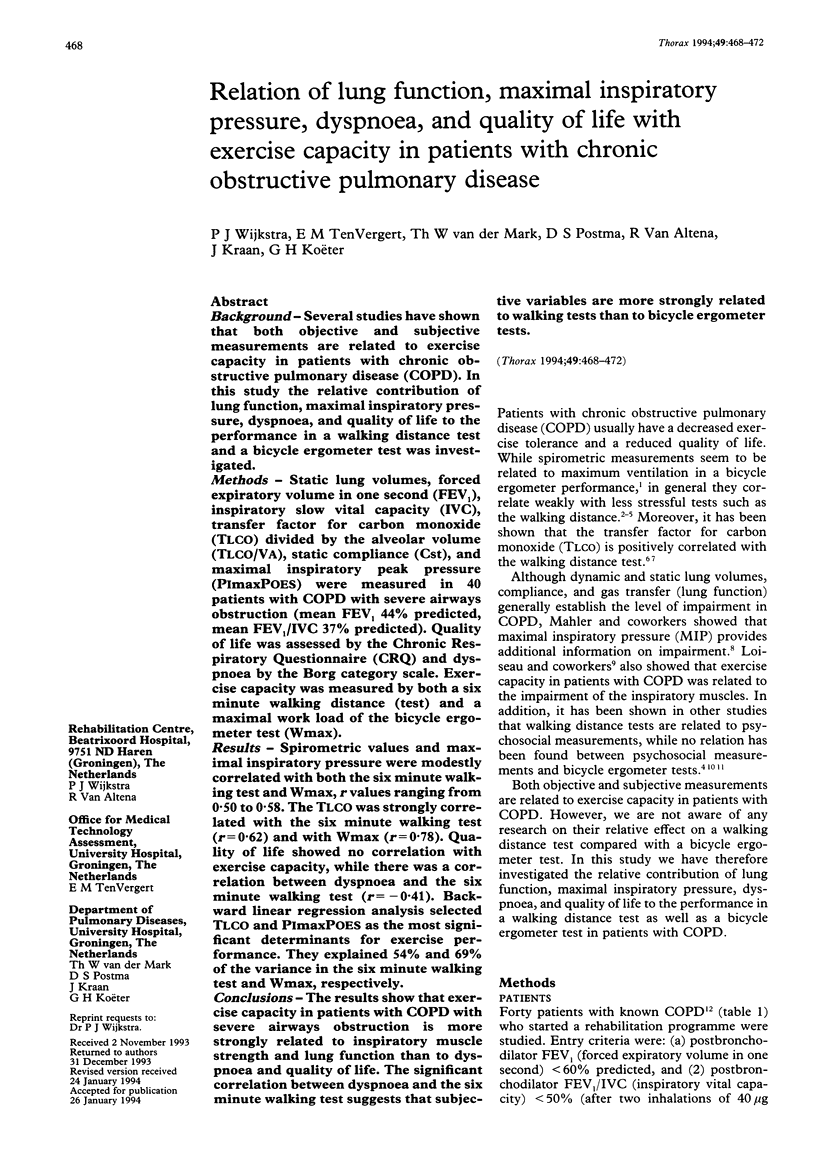
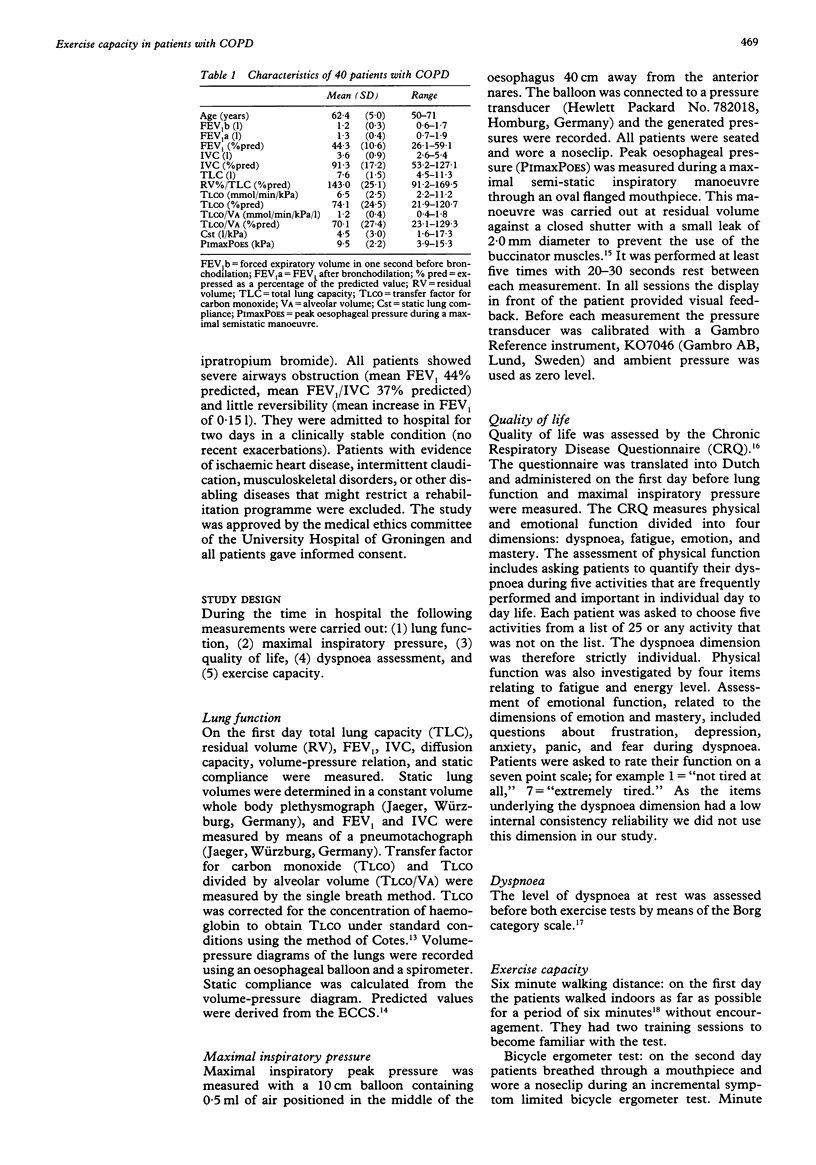
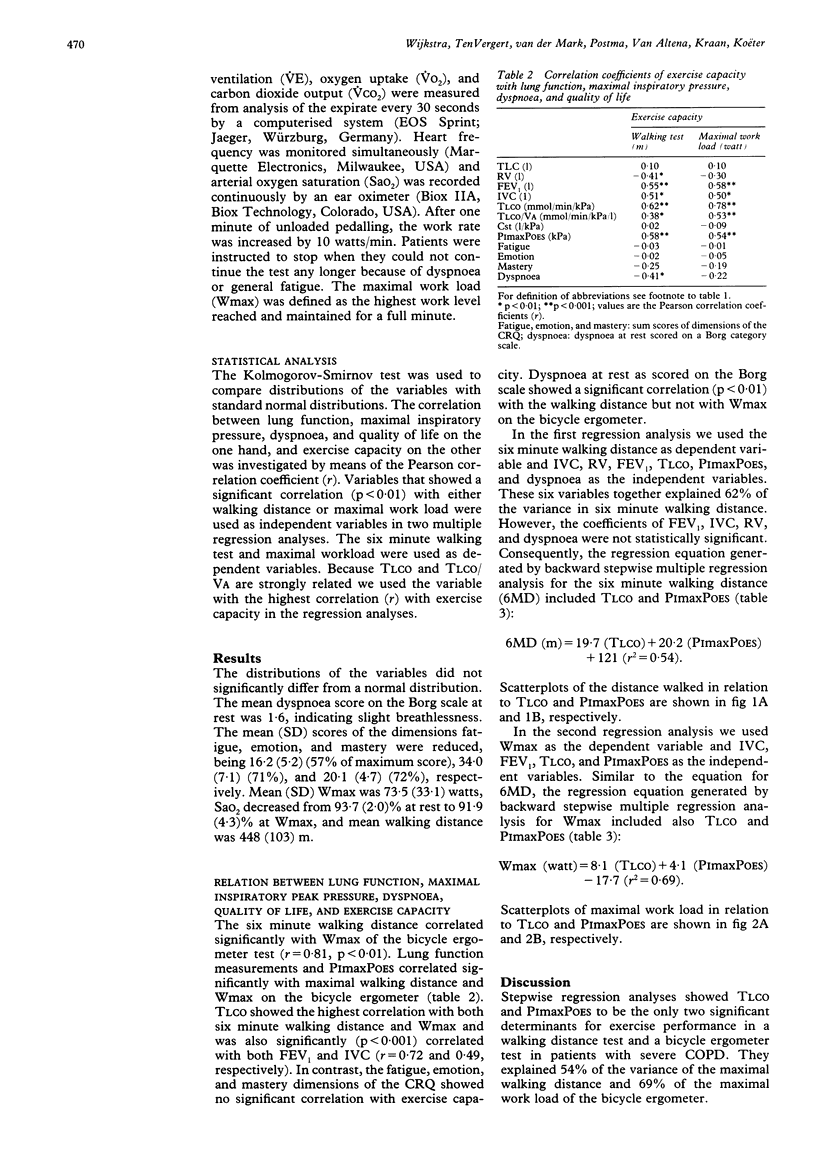
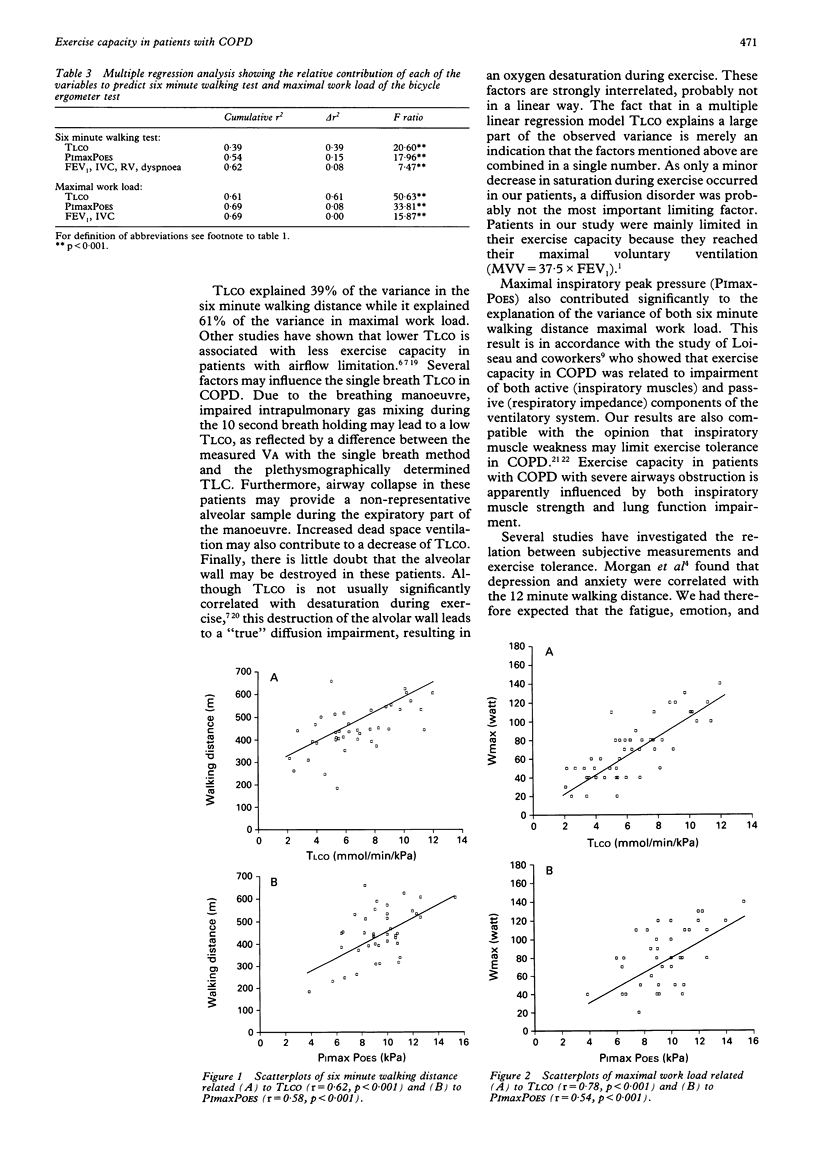
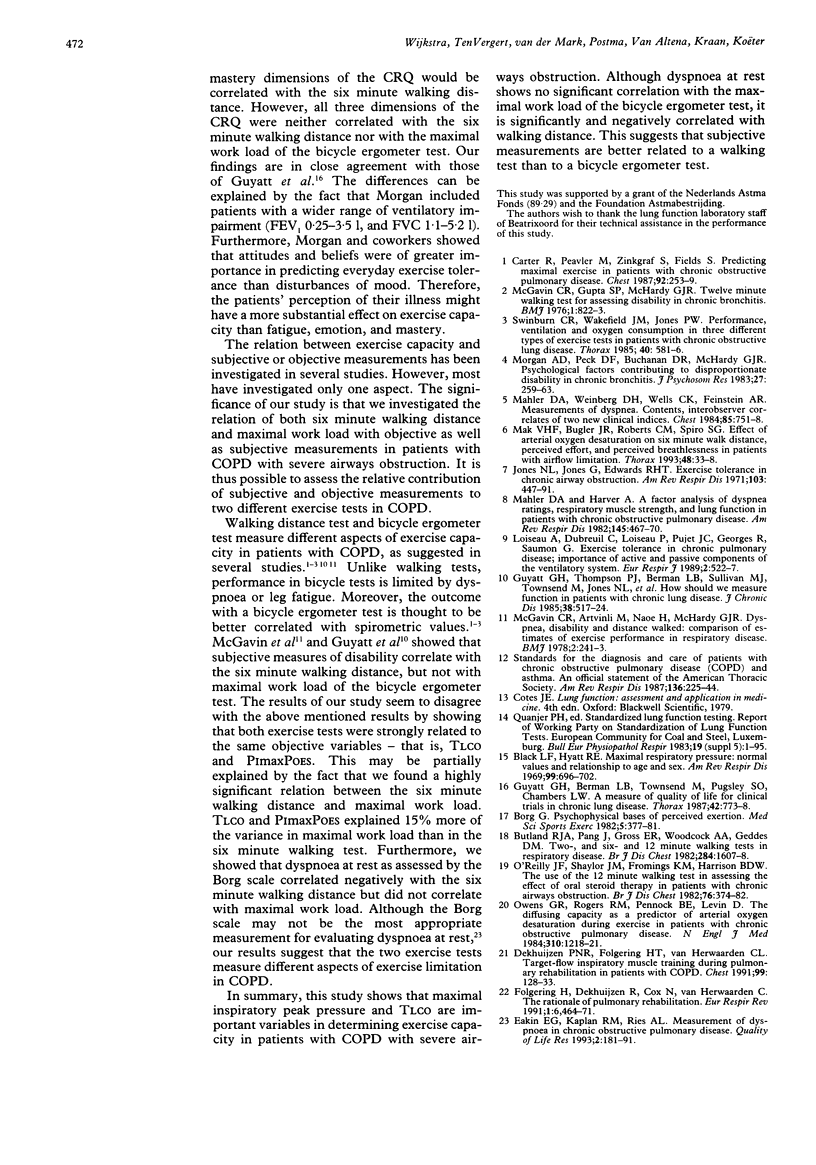
Selected References
These references are in PubMed. This may not be the complete list of references from this article.
- Black L. F., Hyatt R. E. Maximal respiratory pressures: normal values and relationship to age and sex. Am Rev Respir Dis. 1969 May;99(5):696–702. doi: 10.1164/arrd.1969.99.5.696. [DOI] [PubMed] [Google Scholar]
- Borg G. A. Psychophysical bases of perceived exertion. Med Sci Sports Exerc. 1982;14(5):377–381. [PubMed] [Google Scholar]
- Butland R. J., Pang J., Gross E. R., Woodcock A. A., Geddes D. M. Two-, six-, and 12-minute walking tests in respiratory disease. Br Med J (Clin Res Ed) 1982 May 29;284(6329):1607–1608. doi: 10.1136/bmj.284.6329.1607. [DOI] [PMC free article] [PubMed] [Google Scholar]
- Carter R., Peavler M., Zinkgraf S., Williams J., Fields S. Predicting maximal exercise ventilation in patients with chronic obstructive pulmonary disease. Chest. 1987 Aug;92(2):253–259. doi: 10.1378/chest.92.2.253. [DOI] [PubMed] [Google Scholar]
- Dekhuijzen P. N., Folgering H. T., van Herwaarden C. L. Target-flow inspiratory muscle training during pulmonary rehabilitation in patients with COPD. Chest. 1991 Jan;99(1):128–133. doi: 10.1378/chest.99.1.128. [DOI] [PubMed] [Google Scholar]
- Eakin E. G., Kaplan R. M., Ries A. L. Measurement of dyspnoea in chronic obstructive pulmonary disease. Qual Life Res. 1993 Jun;2(3):181–191. doi: 10.1007/BF00435222. [DOI] [PubMed] [Google Scholar]
- Guyatt G. H., Berman L. B., Townsend M., Pugsley S. O., Chambers L. W. A measure of quality of life for clinical trials in chronic lung disease. Thorax. 1987 Oct;42(10):773–778. doi: 10.1136/thx.42.10.773. [DOI] [PMC free article] [PubMed] [Google Scholar]
- Guyatt G. H., Thompson P. J., Berman L. B., Sullivan M. J., Townsend M., Jones N. L., Pugsley S. O. How should we measure function in patients with chronic heart and lung disease? J Chronic Dis. 1985;38(6):517–524. doi: 10.1016/0021-9681(85)90035-9. [DOI] [PubMed] [Google Scholar]
- Loiseau A., Dubreuil C., Loiseau P., Pujet J. C., Georges R., Saumon G. Exercise tolerance in chronic obstructive pulmonary disease: importance of active and passive components of the ventilatory system. Eur Respir J. 1989 Jun;2(6):522–527. [PubMed] [Google Scholar]
- Mahler D. A., Harver A. A factor analysis of dyspnea ratings, respiratory muscle strength, and lung function in patients with chronic obstructive pulmonary disease. Am Rev Respir Dis. 1992 Feb;145(2 Pt 1):467–470. doi: 10.1164/ajrccm/145.2_Pt_1.467. [DOI] [PubMed] [Google Scholar]
- Mahler D. A., Weinberg D. H., Wells C. K., Feinstein A. R. The measurement of dyspnea. Contents, interobserver agreement, and physiologic correlates of two new clinical indexes. Chest. 1984 Jun;85(6):751–758. doi: 10.1378/chest.85.6.751. [DOI] [PubMed] [Google Scholar]
- Mak V. H., Bugler J. R., Roberts C. M., Spiro S. G. Effect of arterial oxygen desaturation on six minute walk distance, perceived effort, and perceived breathlessness in patients with airflow limitation. Thorax. 1993 Jan;48(1):33–38. doi: 10.1136/thx.48.1.33. [DOI] [PMC free article] [PubMed] [Google Scholar]
- McGavin C. R., Artvinli M., Naoe H., McHardy G. J. Dyspnoea, disability, and distance walked: comparison of estimates of exercise performance in respiratory disease. Br Med J. 1978 Jul 22;2(6132):241–243. doi: 10.1136/bmj.2.6132.241. [DOI] [PMC free article] [PubMed] [Google Scholar]
- McGavin C. R., Gupta S. P., McHardy G. J. Twelve-minute walking test for assessing disability in chronic bronchitis. Br Med J. 1976 Apr 3;1(6013):822–823. doi: 10.1136/bmj.1.6013.822. [DOI] [PMC free article] [PubMed] [Google Scholar]
- Morgan A. D., Peck D. F., Buchanan D., McHardy G. J. Psychological factors contributing to disproportionate disability in chronic bronchitis. J Psychosom Res. 1983;27(4):259–263. doi: 10.1016/0022-3999(83)90047-8. [DOI] [PubMed] [Google Scholar]
- O'Reilly J. F., Shaylor J. M., Fromings K. M., Harrison B. D. The use of the 12 minute walking test in assessing the effect of oral steroid therapy in patients with chronic airways obstruction. Br J Dis Chest. 1982 Oct;76(4):374–382. doi: 10.1016/0007-0971(82)90073-0. [DOI] [PubMed] [Google Scholar]
- Owens G. R., Rogers R. M., Pennock B. E., Levin D. The diffusing capacity as a predictor of arterial oxygen desaturation during exercise in patients with chronic obstructive pulmonary disease. N Engl J Med. 1984 May 10;310(19):1218–1221. doi: 10.1056/NEJM198405103101903. [DOI] [PubMed] [Google Scholar]
- Swinburn C. R., Wakefield J. M., Jones P. W. Performance, ventilation, and oxygen consumption in three different types of exercise test in patients with chronic obstructive lung disease. Thorax. 1985 Aug;40(8):581–586. doi: 10.1136/thx.40.8.581. [DOI] [PMC free article] [PubMed] [Google Scholar]


